Characteristics
 The magnificent frigatebird is a large black bird. It is about three feet in length and has a wingspan of over seven feet. The magnificent frigatebird has a long gray bill with a hooked tip. It has a deeply forked, scissor-like tail and sharply pointed wings. The magnificent frigatebird is a large black bird. It is about three feet in length and has a wingspan of over seven feet. The magnificent frigatebird has a long gray bill with a hooked tip. It has a deeply forked, scissor-like tail and sharply pointed wings.
 In the breeding season, male magnificent frigatebirds have a bright red throat pouch that they puff out to attract a mate. Females have white throats and bellies. In the breeding season, male magnificent frigatebirds have a bright red throat pouch that they puff out to attract a mate. Females have white throats and bellies.
Range
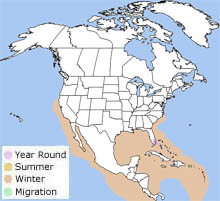 During breeding season, the magnificent frigatebird can be found in coastal Florida and in the tropical Atlantic and Pacific Oceans. In the non-breeding season, it can be found from the coast of North Carolina south to Florida and west to Texas. The magnificent frigatebird can also be found on the coast of California. During breeding season, the magnificent frigatebird can be found in coastal Florida and in the tropical Atlantic and Pacific Oceans. In the non-breeding season, it can be found from the coast of North Carolina south to Florida and west to Texas. The magnificent frigatebird can also be found on the coast of California.
Habitat
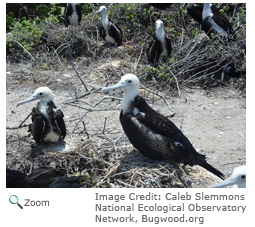 The magnificent frigatebird lives on ocean coasts and islands. In breeding season it lives on mangrove islands. The magnificent frigatebird lives on ocean coasts and islands. In breeding season it lives on mangrove islands.
|
|
Diet
The magnificent frigatebird eats small fish, squid, jellyfish and crustaceans. It may also take young turtles, birds and eggs.
Life Cycle
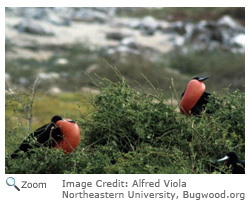 Frigatebirds nest in colonies. Male frigatebirds inflate their red throat pouches to attract a mate. The female frigatebird lays one egg in a nest built of sticks, usually in a clump of mangrove. Sometimes the nest is built in a tree, bush or on the ground. The nest is built by the female. The male brings the materials. Frigatebirds nest in colonies. Male frigatebirds inflate their red throat pouches to attract a mate. The female frigatebird lays one egg in a nest built of sticks, usually in a clump of mangrove. Sometimes the nest is built in a tree, bush or on the ground. The nest is built by the female. The male brings the materials.
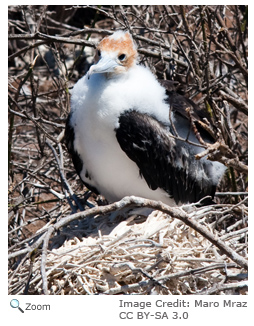 It takes about 50 days for the chick to hatch. Both the male and the female incubate the egg and both parents feed the chick. When the chick is young, one parent is always with it to protect it from the other frigatebirds. The male leaves when the chick is about 12 weeks old. The chick fledges when it is about five to six months old. The female will continue to feed the chick for another four months. It takes about 50 days for the chick to hatch. Both the male and the female incubate the egg and both parents feed the chick. When the chick is young, one parent is always with it to protect it from the other frigatebirds. The male leaves when the chick is about 12 weeks old. The chick fledges when it is about five to six months old. The female will continue to feed the chick for another four months.
Behavior
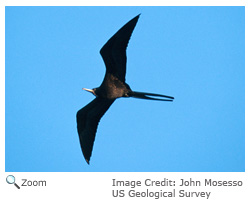 The magnificent frigatebirds is an excellent flyer and glider. It can swoop and grab a booby chick from its nest. It often chases and snatches other food while in the air. The magnificent frigatebirds is an excellent flyer and glider. It can swoop and grab a booby chick from its nest. It often chases and snatches other food while in the air.
|